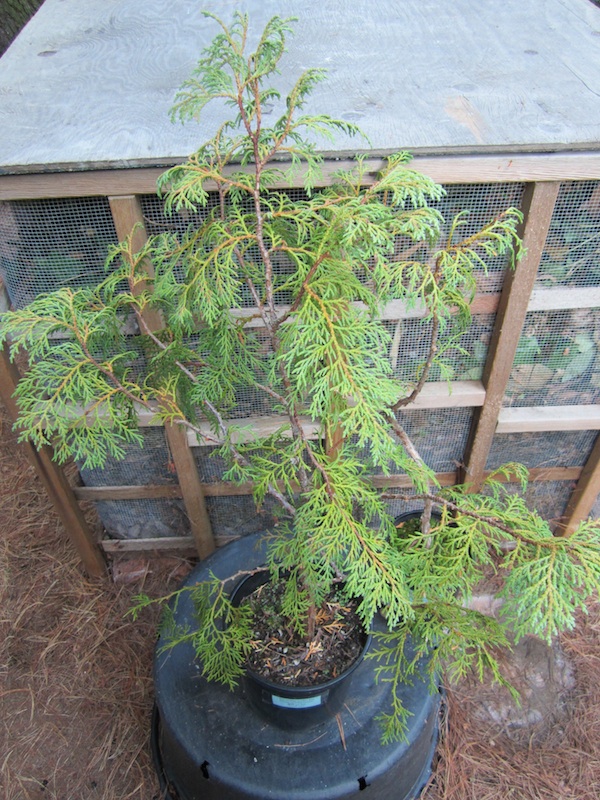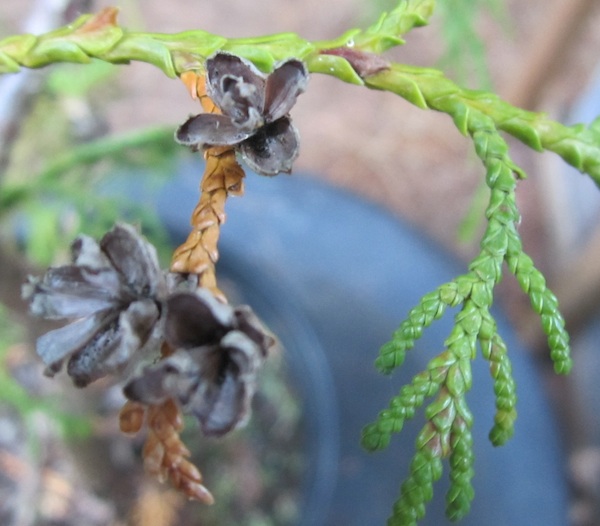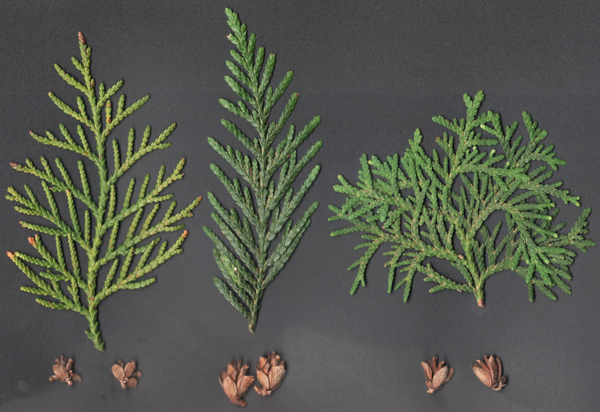Three days before writing this, I was presented with two potted young trees of a rare Chinese tree, about which I knew almost nothing. Now, I am sharing the little information I have gathered in 4 hours, and comparing the rare Chinese tree to two of its common North American relatives. Moreover, I seek a Seattle resident or institution desirous of supplying a home in the ground for these small trees. [Incidentally, I have other rare trees and plants in need of new loving and appropriate homes. Contact me if you desire more details.]
|
There are 5 Thuja species:
|
| Thuja occidentalis L. 1753 |
Arborvitæ or Northern White Cedar
|
| Thuja plicata Donn ex D. Don 1824 |
Giant Arborvitæ or Western Red Cedar
|
| Thuja koraiensis Nakai 1919 |
Korean Arborvitæ
|
| Thuja Standishii (Gord. 1862) Carr. 1867 |
Japanese Arborvitæ
|
| Thuja sutchuenensis Franch. 1899 |
| Sichuan Thuja, Cedar, or Arborvitæ |
Chinese: ya bai (崖柏)
|
| Thuja derives from the Greek thyia or thya, an ancient name used by Theophrastus (370 - 288 BC) for some resin-bearing evergreen, possibly a juniper. Maybe related to thuon, a sacrifice; the resin used as an incense in Eastern sacrifices. |
| Of cedars in general, I wrote the following in my book Trees of Seattle: |
| "For ages the word "cedar" and its cognates in European languages have referred to trees with very fragrant, durable and lightweight wood. In the northern hemisphere these have usually been conifers, but in the tropics and southern hemisphere this is not always so. Neither "cedar" nor the similarly-used common name "cypress" refers to any one genus of trees. The pedantic dictum that there are but few true cedars among a lot of trees wrongly bearing the name is an inappropriate quibble over common usage. |
| As for the cedar genus Thuja, our present subject, I wrote of the first species described, Thuja occidentalis: |
| "In 1535 - 36, Jacques Cartier's expeditionary forces were dying of scurvy. A friendly Canadian native informed them that this tree afforded "a singular remedie agaynst that disease." The desperate men tested it: |
| After thys medicine was founde and proved to be true, there was such strife aboute it, who shoulde be first to take of it, that they were readye to kill one another; that a tree as bigge as anye Oake in Fraunce, was spoyled and lopped bare, and occupyed all in five or sixe dayes, and wroughte so well, that if all the Phisitions of Montpelier, and of Louaine, hadde beene there with all the drugges of Alexandria, they woulde not have done so muche in one yeare, as that tree dydde in five dayes. . . . (Jacques Cartier, in a 1580 English translation) |
| The recovered explorers returned to France, bringing seeds and young plants of the tree to King Francis I, who named it "d'Arbor Vitæ" for its life-preserving qualities and its fragrant evergreen foliage. Its name and fame spread throughout civilized Europe. |
This illustrious evergreen is a small, compact, slow-growing cousin of our native cedar (i.e., the Western Red), similar in bark, foliage and cones. In nature it may reach 125 feet tall with a trunk up to 18 feet in circumference [and live over 1,000 years]. In Seattle most are less than 30 feet tall, and many mere shrubs. Very commonly grown here (mostly cv. 'Fastigiata'), it is used extensively as a foundation planting, for accent, for screens and hedges --rarely is it seen as a single, open-grown specimen. It usually turns bronze-colored in winter."
|
| The Northern White Cedar, or common Arborvitæ, is native to eastern North America. In Northwestern North America, including Seattle, our native cedar is Thuja plicata, commonly called Western Red Cedar. Other names are Pacific Red Cedar, Giant Arborvitæ, Shingle Cedar, Canoe Cedar and Giant Cedar. I wrote of it: |
| "Seattle has only one native cedar, but what a tree! Big, abundant, well known, valuable, it's a living monument to firm, unyielding resolve: deeply anchored in earth, strongly ascending towards heaven, mocking the might of the wind, resistant to rot, vigorously enduring for untold centuries [it can live over 2,000 years]. |
| It stands unrivaled in size by any other cedar on earth, capable of attaining dimensions of 277 feet in height with a maximum trunk circumference of 78 feet or even more. The wood is so famous for its durability that certain scoundrels make an illegal living by "cedar rustling" much as their criminal counterparts in the East poach Empress Tree and Black Walnut trees. To the Indians of this area it was by far the most important tree. |
It can be seen everywhere in Seattle, both wild and planted. Its irregularly fluted, swollen base, and fibrous, reddish bark are distinctive. Very old specimens are generally hollow, frequently with elbowy, forking crowns, surmounted by dead, gray snag tips. Off the beaten path in Seward Park is a titan hundreds of years old, fire-hollowed so that a person can walk in one side and out the other. The wood decays so slowly that many parks have huge old stumps remaining from the pioneer logging era, such as one in Carkeek Park over 25 feet in circumference."
|
| Both of the preceding two Thuja species have strongly aromatic foliage, so that when they are being pruned, or merely if a twig is scratched or the foliage bruised, the volatile odor is released. A person can readily learn to tell the two apart by smell. To me, Thuja plicata is more fruity, and Thuja occidentalis more acrid. |
| In contrast to both of these American species, the rare Chinese tree --assuming the two youngsters in my possession are representative-- bears notably weakly scented foliage. Moreover, its cones are smaller, and so are its tiny leaves. |
| The Chinese Thuja is the rarest Thuja. Discovered in 1892, and practically unknown in Western cultivation, it had been thought extinct in the wild, yet was then rediscovered in 1999 on steep limestone ridges of the Daba Shan mountains north of Chengkou county, Chongqing / Chongking Municipality, of NE Szechwan / Szechuan / Sichuan. It is still listed as critically endangered. The oldest are estimated over 500 years. It can reach 65 feet in height in the wild, but may be capable of more in cultivation, eventually. |
| This tree has been represented in U.S. nursery trade since 2005 or earlier, in at least a cutting-grown clone, that was introduced by Buchholz & Buchholz nursery of Oregon. That nursery obtained the clone from the Atlanta Botanical Garden, who had obtained it from a source on Long Island --likely John Silba. The clone was collected in China in 1944, and in 1997 Silba gave a cutting to the Arnold Arboretum, near Boston. |
| There have been trees sold under the name Thuja sutchuenensis that were mislabeled. Inasmuch as I am personally familiar with the characteristics of the 4 commonly grown Thuja species, the young plants that were obtained from Buchholz & Buchholz nursery and given to me, appear distinctive, and appear to fit the published botanical description of Thuja sutchuenensis. Namely: small, bluntish, non glaucous, non glandular leaves, and small cones. (In May, 2018, Jean Hoch wrote to me that my photos show a non-glaucous Thuja Standishii, and that Silba had identified wrongly the Long Island tree as Thuja sutchuenensis.) |
| For detailed botanical information about this, you may consult: Botanical Journal of the Linnaean Society 139(3) (2002): pages 305 - 310: Thuja sutchuenensis: a rediscovered species of the Cupressaceae. By Xiang Qiaoping, Farjon, Aljos, Li Zhenyu, Fu Likuo and Liu Zhengyu. |
Here is a link to that PDF (www.aseanbiodiversity.info).
Back
|

young Thuja sutchuenensis in a pot; photo by ALJ
|

Thuja sutchuenensis foliage and cones; photo by ALJ |

Thuja sutchuenensis (left) Thuja plicata (middle) and Thuja occidentalis (right) foliage and cones; scan by ALJ |

